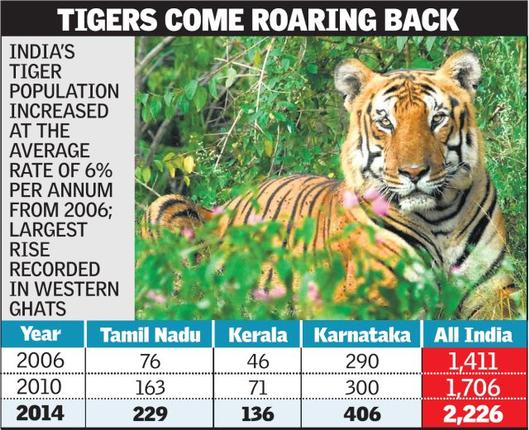India now has 70 per cent of the tiger population in the world with the latest assessment estimating 2,226 big cats, up 30 per cent from 1,706 in 2010, show preliminary estimates in “Status of Tigers in India, 2014.”
The largest increase is recorded in the Western Ghats Landscape complex — Kerala, Karnataka, Goa and Tamil Nadu — with 776 tigers (up from 402 in 2006). The Mudumalai-Bandipur-Nagarahole-Wayanad complex holds the world’s single largest tiger population currently estimated at over 570 tigers (in 11,000 sq.km of habitat), the report says. Goa now has a persistent tiger presence with three to five animals.
However, the Sunderbans did not report an increase in the numbers because of a low prey base and other factors. Odisha reported a fall in number.
Releasing a summary of figures of the third round of the country-level tiger assessment, Union Minister of State for Environment and Forests Prakash Javadekar said here on Tuesday that the increase in numbers was a great achievement and a result of the combined efforts of passionate officers.
With so many tigers, India could send them to countries where there was demand for them. Mr. Javadekar said 9,753 camera traps had been set up and over 100 people were trained to use them.
The latest round of assessment used state-of-the art technology of double sampling, using camera traps to estimate the assessment and distribution of tigers over 3,78,118 sq.km of forests in 47 reserves in 18 States. The only portions which were not scanned were some parts of the north-east and Jharkhand.
Rajesh Gopal, Additional Director and head of the National Tiger Conservation Authority, said the state-of-the art technology meant that there was very little extrapolation based on data. There were 1,540 photos of individual tigers aged above a year and a half for the first time.
Mr. Gopal said tigers from India had been in demand in countries such as Laos and Cambodia.
Tackling of tiger poaching pays off, says official
The tiger population had increased in Karnataka, Uttarakhand, Madhya Pradesh, Tamil Nadu and Kerala, Additional Director and head of the National Tiger Conservation Authority Rajesh Gopal told journalists on Tuesday.
Y.V. Jhala, one of the principal investigators of the report, said this was only a summary and a detailed report would be ready by March-end. Assessment was in progress in the Simlipal and Satpuda tiger reserves.
The population had increased at the rate of six per cent per annum in India from 2006 while the world lost 97 per cent tigers in the last 50 years in 13 countries, Dr. Jhala said. The main reasons for this increase were effective tackling of poaching, and the positive attitude of the wildlife services.
“We were in for a huge surprise as we didn’t expect the numbers to be above 1,800 or 1,900,” said Dr. Jhala. While 1,540 tigers were actually photographed, the rest were estimated based on this. However, for long term survival, the movement of tigers was essential and corridors between forests would be the next conservation goal, he added. The priority should now change to landscape scale management, he added.








